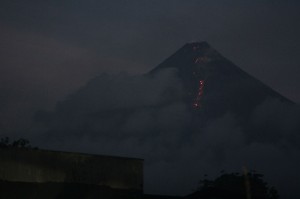Magma rising inside Mayon, says Phivolcs

A photo of Mayon Volcano captured at around 3 a.m. on September 16, 2014, Tuesday, shows lava cascading from its crater, as viewed from Barangay Rawis, Legazpi City.
INQUIRER SOUTHERN LUZON/MARK ALVIC ESPLANA
LEGAZPI CITY, Philippines—The Philippine Institute of Volcanology and Seismology (Phivolcs) said it expected more magma to move up the summit of Mayon volcano due to the huge volume of lava clogging its crater.
“We expect more magma extruding,” said Eduardo Laguerta, Phivolcs resident volcanologist here, in a press briefing on Tuesday. By extrusion, he meant the magma was being pushed or moved up.
He said that as the huge lava dome continued to block the crater, the tendency was for the magma to pile up and build pressure for its upward journey to the summit.
Laguerta said the increasing volume of gas emitted by the volcano indicated the “magma is extruding slowly” or moving up slowly.
Phivolcs, in its Tuesday morning bulletin, reported sulfur dioxide emissions of 1,421 tons compared to the 1,265 tons on Sept. 27, and only one volcanic earthquake and three rock fall events, compared to the previous two quakes and four rock fall events.
Laguerta said the higher gas emission “makes the magma less dense, which may allow the magma to continue its upward journey that may lead to explosion.”
The volcano has been under Alert Level 3 since Sept. 15.
The Department of Health (DOH) and the Center for Health and Development in Bicol meanwhile installed more toilets and repaired others at evacuation centers in Albay.
DOH Bicol Director Gloria Balboa said the new toilets, also known as trench latrines or kybos toilet bowls, did not require water for flushing but only soil to cover the dirt.
Nathaniel Rempillo, provincial health officer, said they recorded 486 cases of illness among evacuees that had now been in 45 evacuation centers in Albay for two weeks.
“This is not yet alarming since there are no emerging epidemic diseases,” he said.
Rempillo said nearly half of the cases were of acute respiratory infection, while the rest were of fever, headache, hypertension, wounds, diarrhea, skin disease, toothache, ear pain and asthma.
The Philippine Army, meanwhile, is observing the “no human activity rule” within the 6-km danger zone around Mayon to keep the evacuees from harm.
Lt. Col. Perfecto Penaredondo, commanding officer of the 2nd IB based in Ligao City, said checkpoints and choke or blocking points had been established to prevent residents from entering declared danger areas.














